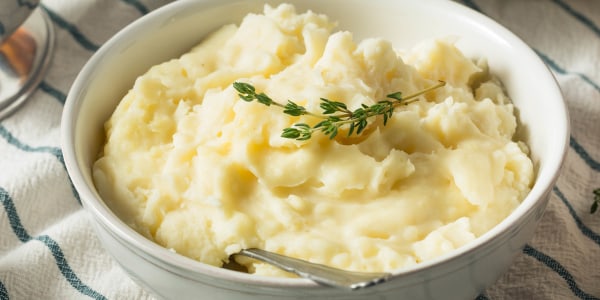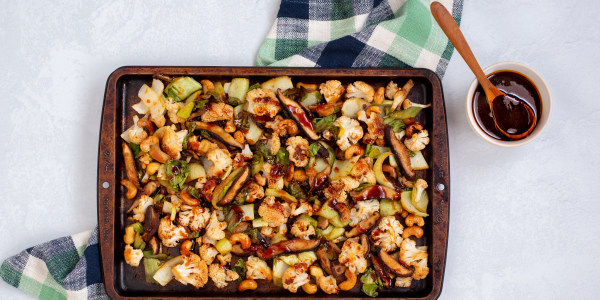Cauliflower is doing a lot these days. Not only is it a vitamin-packed vegetable in its own right, but cauliflower is also doing double duty as an ingredient in low-carb pizza crust and mashed "potatoes."
And, when you look at the nutritional benefits of cauliflower, it makes sense why this cruciferous veggie is popping up in so many unexpected places.
Cauliflower is rich in folate, a B vitamin, as well as vitamin C, vitamin K and fiber, Debbie Petitpain, registered dietitian and spokesperson for the Academy of Nutrition and Dietetics, tells TODAY.com.
"Plus, its mild flavor profile makes it easy to use as a substitute for starches, such as potato, rice and flour," she says. That, along with cauliflower's low calorie and carb count, makes it an appealing option for people looking to manage their blood sugar or weight, Petitpain adds.
Here's why cauliflower has become such an all-star vegetable.
Cauliflower nutrition
In one cup of chopped raw cauliflower, you'll find:
- 27 calories
- 2 grams protein
- 0.3 grams fat
- 5 grams carbohydrates
- 2 grams fiber
Cauliflower benefits
Cauliflower, like all cruciferous vegetables, is part of the cabbage family, registered dietitian Grace Derocha, tells TODAY.com. "They're just different parts of the cabbage," she says.
Right off the bat, know that it’s a great source of vitamin C. In a single floret — “literally one piece of cauliflower" — you'll get at least 10% of your daily vitamin C, adds Derocha, who is also a spokesperson for the Academy of Nutrition and Dietetics.
Cauliflower is also rich in vitamin B-9, also called folate, which is necessary for development in childhood and pregnancy. A cup of cauliflower also contains 20% of your daily vitamin K, Derocha says, which we need for proper blood clotting and wound healing. Note that cauliflower also comes with a bit of fiber and protein, which can aid in feelings of satiety and fullness, Derocha says.
Additionally, cauliflower contains choline, which is helpful for both sleep and muscle movement, Derocha says. "Not only does (choline) allow you to fall into sleep, but it allows you to have better, deeper sleep as well."
Different colors of cauliflower contain nutrient bonuses
As with carrots, cauliflower naturally comes in different colors. And each of those colors can carry unique nutritional benefits.
For instance:
- White cauliflower, while not as vibrant, comes with a variety of antioxidants, Derocha says. It's also rich in sulfur-containing compounds that may help slow the progress of cancer, including breast cancer, Petitpain says.
- Purple cauliflower contains anthocyanins, a type of antioxidant that's also found in blueberries.
- Yellow or orange cauliflower contains higher levels of beta-carotene, Petitpain says, which the body converts into vitamin A.
Cauliflower can help replace starchier vegetables
One of cauliflower's many benefits is that its texture and mild flavor make it a highly versatile vegetable, allowing you to reduce carbs and calories in some dishes while increasing the nutrient content.
"Using cauliflower as a substitute can reduce calories and carbohydrate content and increase the fiber and nutritional value to some foods," Petitpain explains. Not everyone needs to worry about this, but it can be especially helpful for those who are watching their weight or blood sugar.
"I love a carb, and I think people have demonized carbs so much," Derocha says, "but if you have a family history of diabetes, you're currently pre-diabetic, you are a person with diabetes or you're trying to just be a little bit more strategic, cauliflower as a mix-in is great."
And it doesn't have to be all or nothing, she says. Just substituting part of the other ingredients with cauliflower can have a huge impact.
"For people trying to reduce caloric content, replacing 1 cup rice with 1 cup riced cauliflower will save about 175 calories and 45 grams of carbs," Petitpain explains, "which is significant for people trying to manage their blood sugar or their weight."
For instance, when Derocha makes mashed potatoes for her family, which includes someone with diabetes, she uses white beans, potatoes and cauliflower all mixed. "No one can tell the difference," she says.
Additionally, making some foods, like pizza crust, with cauliflower instead of traditional flours also makes them naturally gluten-free, Petitpain says. However, with the addition of other ingredients, like cheese and pizza toppings, the gluten-free version isn't necessarily going to be lower in calories, she adds.
Can you eat the leaves and stems?
The stems and leaves of a cauliflower are edible, Derocha says.
Because they can have a thick, dense texture, the leaves may be best saved for use in soups, stews or vegetable stock, she explains. But if you're making "riced" or pureed cauliflower as part of a recipe, you can go ahead and include the stem.
Are there any downsides to eating a lot of cauliflower?
"Cauliflower is high in oligosaccharides, a type of natural plant sugars, which humans can’t digest well," Petitpain says. Eating a lot of these sugars can cause gas, bloating and discomfort, but cooking the cauliflower reduces the oligosaccharides and the related side effects.
And keep in mind that those sugars cause gas because they're essentially "feeding" the beneficial bacteria in your gut, "which promotes gut health, reduces constipation and can even improve the overall immune system," Petitpain explains.
Also be aware that cruciferous vegetables, including cauliflower, contain compounds called goitrogens. These naturally occurring compounds can interfere with the "absorption of iodine, which your thyroid needs," Derocha says. However, cooking cauliflower neutralizes the effect, she adds.
So, people who have a history of thyroid conditions may want to limit the amount of raw cauliflower they eat or discuss their options with a registered dietitian.



